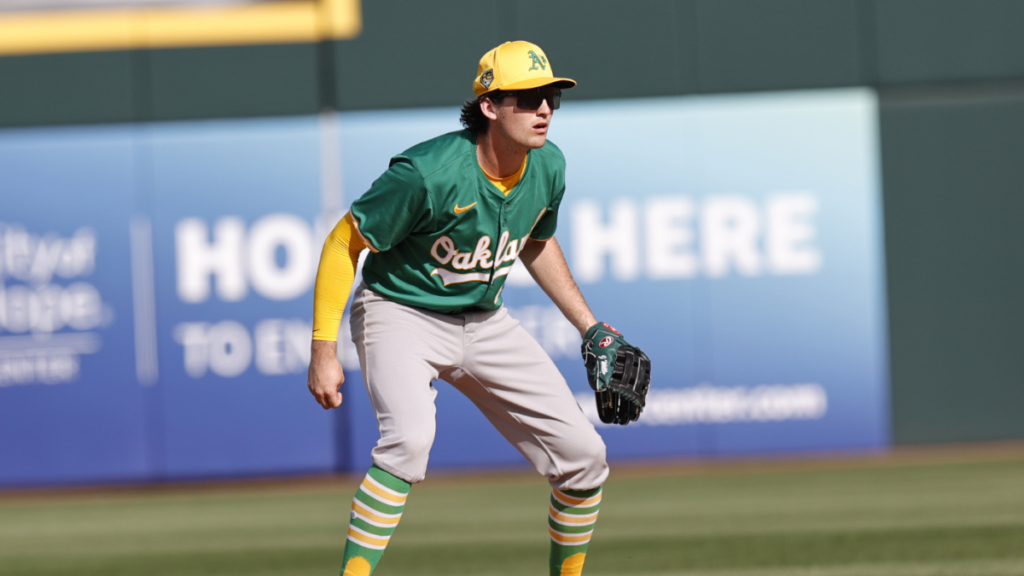The Oakland Athletics are expected to promote shortstop prospect Jacob Wilson to the majors on Friday, ahead of their season-resuming series against the Los Angeles Angels.
Wilson, the sixth pick in last summer’s draft, will attempt to give the Athletics something they’ve lacked for most of the season: solid production at the shortstop position. In 19 games at the Triple-A level, he batted .398/.444/.639 with four home runs and more walks than strikeouts. Overall this season, he’s hit .438/.475/.687 in 200 plate appearances.
No one could be blamed for contemplating Wilson’s statistics and bloodlines (his father Jack was a long-time MLB shortstop) and concluding that this is it, this is the turning point the Athletics have been waiting for since dismantling their old core in early 2022. Even their temporary home in Sacramento should, in theory, be the start of something new, and hopefully good, for John Fisher’s club. Unfortunately, we’re not so sure about that. Below, we’ve expanded on three reasons why.
1. Polarizing skill set
Anyone who followed our draft coverage of Wilson last summer knows that he’s a divisive prospect. The gist of it is that he’s an extreme contact hitter (he connected on more than 93% of his swings in Triple-A) with bottom-of-the-scale strength. His average exit velocity in Triple-A (84.3 mph) would rank 244th out of 250 qualified MLB players, and his maximum exit velocity (106.1 mph) would check in around the same territory.
In other words, it’s an extreme min-max offensive profile — and those tend to inspire skepticism about their portability until they actually work against big-league pitching. Despite outstanding minor-league results, Wilson is no exception to that phenomena.
It certainly doesn’t help anyone make heads or tails of the situation that Wilson’s ascent comes at a time when front offices have expressed consternation about reading too much into minor-league results while things get settled following the reorganization.
If you’re a Wilson believer, you’re envisioning him succeeding the same way that Luis Arraez and Steven Kwan have; if you’re not, you probably have the names Nicky Lopez and Kevin Newman in mind instead. The good news for Wilson is that he is a skilled defender at the six, lowering the offensive threshold he needs to clear in order to hold value.
2. Uncertainty about rest of core
Whatever you make of Wilson, good or bad, there’s no denying that it’s usually a foolish endeavor to pin your hopes for the future on a single player.
Besides, the A’s have already been undergoing a youth movement for some time. Three of their top four plate appearance recipients are in their age-26 seasons or younger. Expand the scope a little, and that’s true of five of their 11 most commonly used position players. We’re not just talking about random youngsters they pulled up to fill a spot, either.
Tyler Sodersom and Zack Gelof are former top-60 picks, and JJ Bleday and Shea Langeliers were top-10 picks before they were trade acquisitions. Lawrence Butler, originally a sixth-round pick, is the only player who didn’t have legit prospect credentials. Of those five, only one (Bleday) has an OPS+ over 110; Soderstrom is the next highest, at 105, and Langeliers and Butler are both at or around 100. (Gelof is below 90.)
When it comes to young players, you’d be foolish to just look at results and results only. Part of the evaluative game is projecting growth (or decline). Soderstrom’s advanced metrics, for instance, are more promising than his topline numbers suggest — that indicates there’s some room for improvement. Langeliers’ too. The A’s will need those players, plus more, to continue to develop if they want to rejoin the competitive ranks.
Do note that we haven’t even addressed a pitching staff that ranks 13th in the American League in ERA despite a favorable environment. Mason Miller is fantastic, and we think Joey Estes has a chance to work out. How many others on this staff are you actually optimistic about being on the team in two years’ time? (Heck, even Miller is not a given considering the trade rumors swirling around him ahead of MLB’s July 30 deadline.)
There are some steady (or potentially steady) players in Oakland. But they’re going to need a lot of reinforcements before they’re ready to compete with the Mariners, Astros, and Rangers.
3. Lacking farm system
On a related note, you might suspect that the A’s have a thriving farm system. After all, they traded away all those stars for prospects just over two years ago, and they’ve made four top-10 selections since 2017. And yet, not so much. This isn’t the case where we’re the low vote, or perhaps have undervalued some of the prospects they have on their farm, either.
Baseball Prospectus had one Athletics player (Wilson) in their recent top-50 update. FanGraphs gave three A’s players (two of them Wilson and Miller) 50-plus grades in May. Miller has since graduated, and Wilson should before long. That leaves right-hander Luis Morales and first baseman Nick Kurtz (the No. 4 pick in this summer’s draft) as the best prospects in this system — and let’s face it, the history of first-round collegiate first basemen is so dreadful you’d be justified feeling bearish on Kurtz.
The nature of baseball is that some other players will probably emerge from the rest of the system. One thing the Athletics can offer that competitive teams can’t is opportunity; sometimes, players take full advantage of their chances and stick.
However, the A’s situation differs from that of Washington or Pittsburgh, where a steady stream of top prospects seamlessly transitioned the team from the bottom of the standings to respectability.
Therefore, despite Wilson’s addition after another period of rebuilding, the A’s road back to relevance remains surprisingly murky.

